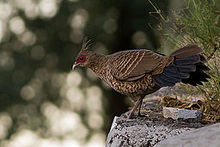Kalij pheasant
| Kalij pheasant | |
|---|---|

| |
| MaleL. leucomelanos hamiltoni,Uttarakhand,India | |

| |
| FemaleL. leucomelanos hamiltoni,Uttarakhand, India | |
| Scientific classification | |
| Domain: | Eukaryota |
| Kingdom: | Animalia |
| Phylum: | Chordata |
| Class: | Aves |
| Order: | Galliformes |
| Family: | Phasianidae |
| Genus: | Lophura |
| Species: | L. leucomelanos
|
| Binomial name | |
| Lophura leucomelanos (Latham,1790)
| |
Thekalij pheasant(Lophura leucomelanos), or simplykalij,is apheasantfound in forests and thickets, especially in theHimalayanfoothills, from Nepal,Pakistanto westernThailand.Males are rather variable depending on thesubspeciesinvolved, but all have at least partially glossy bluish-blackplumage,while females are overall brownish. Both sexes have a bare red face and greyish legs (the latter separating it from the red-leggedsilver pheasant).[2]It is generally common and widespread, though three of its eastern subspecies (L. l. oatesi,L. l. lineata,andL. l. crawfurdi) are consideredthreatenedandL. l. moffittiis virtually unknown in the wild.[2]On 21 October 2021, theGovernment of Jammu and KashmirdeclaredKalij Pheasantas bird of theUnion Territory of Jammu and Kashmir.[3]
The name is also spelledkaleegein old texts, such asGame Birds of India and AsiabyFrank Finn,[4]though no longer in hisIndian Sporting Birds.[5]The species was introduced toHawaii[1]in 1962 as agamebird.[6]
Taxonomy
[edit]The kalij pheasant is closely related to the silver pheasant, and the two are known tohybridize.[7]The placement of thetaxaL. l. lineataandL. l. crawfurdihas been a matter of dispute, with some treating them as subspecies of the kalij pheasant[2]and others as subspecies of the silver pheasant.[8]They have greyish legs as in the kalij pheasant, but theirplumageis closer to that of some subspecies of the silver pheasant. Additionally, as the silver pheasant,L. l. lineataandL. l. crawfurdiare found east of theIrrawaddy River,a majorzoogeographicbarrier, while all other subspecies of the kalij pheasant are found west of the river (L. l. oatesi,a subspecies of the kalij pheasant, has sometimes been reported as occurring east of that river,[2]but this is incorrect[9]). Based onmtDNA,it was recently confirmed thatL. l. lineataandL. l. crawfurdishould be regarded as subspecies of the kalij pheasant.[10]
Subspecies
[edit]The nine recognizedsubspeciesof the kalij pheasant are, in taxonomic order:
- L. l. hamiltoniJ.E. Gray,1829)– white-crested kalij pheasant – westernHimalayas
- L. l. leucomelanos(Latham,1790)–nominate– forests ofNepal
- L. l. melanota(Hutton, 1848)– black-backed kalij pheasant –Sikkimand westernBhutan
- L. l. moffitti(Hachisuka,1938)– black kalij pheasant – centralMyanmar
- L. l. lathami(J.E. Gray, 1829)– Horsfield's pheasant – easternBhutanand northern India to Myanmar
- L. l. williamsi(Oates,1898)– Williams' kalij pheasant – western Myanmar
- L. l. oatesi(Ogilvie-Grant,1893)– Oates' kalij pheasant – southern Myanmar
- L. l. crawfurdi(J.E. Gray, 1829)– Crawfurd's pheasant – southeastern Myanmar to peninsular Thailand
- L. l. lineata(Vigors, 1831)– lineated pheasant – southern Myanmar to northwestern Thailand
Description
[edit]
Males have a total length of 63 to 74 cm (25 to 29 in) and females 50 to 60 cm (20 to 24 in).[2]Height is... Very roughly, the subspecies can be divided into two main groups, with the first (subspeciesL. l. hamiltoni,L. l. leucomelanos,L. l. melanota,L. l. moffitti,andVlathami) being found in the western and central part of the species' range, while the second (L. l. williamsi,L. l. oatesi,L. l. lineata,andL. l. crawfurdi) is found in the eastern part. In the males of the first group, most of plumage is glossy blue-black, though with white to the rump or underparts in most subspecies, and inL. l. hamiltoni,the westernmost subspecies, the crest is white (all other have a blue-black crest). In the second group, the underparts and crest are glossy blue-black, but the tail and upperparts are white (or very pale grey) with most feathers densely vermiculated with black.[2]
Females are brownish. In some subspecies, the underparts are distinctly marked in whitish and black, while in others, most feathers are pale-edged, resulting in a scaly appearance.[2]
UT Bird of Jammu and Kashmir
[edit]On 21 October 2021, theGovernment of Jammu and Kashmirdeclared Kalij Pheasant as bird of theUnion Territory of Jammu and Kashmir.
Kalij Pheasant is known as Wan Kokur, Wan Kokud or Ban Kokur in theKashmiri language,which can be translated aswild cock.[3]
References
[edit]- ^abBirdLife International (2016)."Lophura leucomelanos".IUCN Red List of Threatened Species.2016:e.T22679217A92807873.doi:10.2305/IUCN.UK.2016-3.RLTS.T22679217A92807873.en.Retrieved12 November2021.
- ^abcdefgMcGowan, P. J. K. (1994). Kalij Pheasant (Lophura leucomelanos). pp. 533 in: del Hoyo, J, A. Elliott, & J. Sargatal (1994).Handbook of the Birds of the World.Vol. 2. New World Vultures to Guineafowl. Lynx Edicions.ISBN84-87334-15-6
- ^ab"Kalij Pheasant declared as bird of Jammu & Kashmir UT".The Chenab Times.21 October 2021.Retrieved21 October2021.
- ^Finn, F. (1911?).Game Birds of India and Asia.
- ^Finn, F. (1915).Indian Sporting Birds.
- ^"Lophura leucomelanos | Kalij pheasant".hawaiibirdingtrails.hawaii.gov.State of Hawaii. Retrieved 25 February 2018.
- ^MacKinnon, J., & K. Phillipps (2000).A Field Guide to the Birds of China.Oxford University Press.ISBN0-19-854940-7
- ^McGowan, P. J. K., A. L. Panchen (1994).Plumage variation and geographical distribution in the Kalij and Silver Pheasants.Bulletin of the British Ornithologists' Club.114: 113-123.
- ^Robson, C. (2000).A Field Guide to the Birds of South-East Asia.New Holland Publishers.ISBN1-85368-313-2
- ^Moulin, S., E. Randi, C. Tabarroni, & A. Hennache (2003).Mitochondrial DNA diversification among the subspecies of the Silver and Kalij Pheasants, Lophura nycthemera and L. leucomelanos, Phasianidae.Ibis145: E1-E11
External links
[edit]![]() Media related toLophura leucomelanosat Wikimedia Commons
Media related toLophura leucomelanosat Wikimedia Commons

